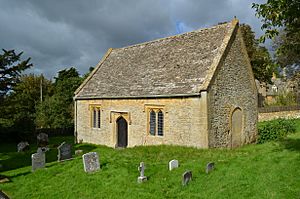St Faith, Farmcote facts for kids
Quick facts for kids St Faith, Farmcote |
|
|---|---|

St Faith, Farmcote
|
|
| Location | Gloucestershire |
| Denomination | Anglican |
| Architecture | |
| Functional status | Monthly service |
| Heritage designation | Grade I |
| Administration | |
| Parish | Guiting Power with Farmcote |
| Archdeaconry | Cheltenham |
| Diocese | Gloucester |
| Province | Canterbury |
St Faith, Farmcote is a very old and small church. It is found in a tiny village called Farmcote in Gloucestershire, England. This special building is about two miles north-west of Temple Guiting.
The church was built a very long time ago. It dates back to the time of the Anglo-Saxons or early Normans. This means it is over 900 years old! It was made from strong limestone rocks. St Faith's is so important that English Heritage has given it a Grade I listed building status. This means it is a building of exceptional historical interest.
Contents
About St Faith's Church
St Faith's is a small church, sometimes called a chapel of ease. It sits on a hill in Farmcote, looking over the beautiful Severn Valley. The church was built using rough limestone pieces. Its roof is also made of limestone, which helps it last a long time.
Original Design and Changes
When it was first built, the church had a simple shape. It had a main hall, called a nave, and a smaller area at the end, called a chancel. The chancel was later taken down. What we see today are parts of the original building. These include the old nave, a doorway that has seen many years, and a special double bellcote. A bellcote is a small structure on the roof that holds bells.
Inside the Church
Inside, you can see two windows from the 1400s. These windows are made of stone and have pretty, leaf-like shapes at the top. The main door is also very old and has metal studs.
On the north wall, there is a large stone tomb. It belongs to Henry and Mary Stratford from the late 1500s. You can see a stone figure of Mary Stratford on the tomb. On the west wall, there is an old font. A font is a basin used for baptisms. This one is from the early English Gothic period. It has a round bowl on top of four pillars.
Near the altar, there is a small stone basin called a piscina. This was used for washing holy vessels. Most of the furniture in the church is from the 1600s. This includes a reading desk, a carved chair, a wooden pulpit, and oak benches from 1597. The altar table is covered by a very old stone slab from the 1200s. This slab has five crosses carved into it.
Roof and Bells
The church has an original wooden roof inside. It has large, curved beams that have supported the roof for centuries. At the top of the west end of the church, there is a rare Norman double-arched bellcote. This is where the bells would have hung. Today, one bell still hangs inside the nave. The red tile floor you see was put in during the 1800s. Outside, the main doorway has carvings of Tudor roses. There is also a blocked-up door on the north wall with a rounded arch.
History of St Faith's
St Faith's church has a long history. It started as a small chapel connected to a larger church in Guiting Power, about five miles away. This type of chapel was called a "chapel of ease." It made it easier for people in Farmcote to attend church.
In the late 1800s, people dug around the church. They found that the church originally had a round chancel. The remains of this old part are now buried underground.
Near the church, there was a manor house built in 1320. This house belonged to the Stratford family. Some famous members of this family included John de Stratford, his brother Robert de Stratford, and Ralph Stratford.
The church is very important because it has been kept in such good condition. Its Grade I listed building status means it is protected. It helps us understand what churches looked like many centuries ago.

